Sustainability assessment of potato fields using the DEXi decision support system in Hamadan Province, lran
Mohammed Ebrahim Rezaei, Morteza Barmaki, Hadi Veisi
1 Department of Agronomy and Plant Breeding, University of Mohaghegh Ardabili, Ardabil 1136756199, Iran
2 Environmental Sciences Research Institute, Shahid Beheshti University, Tehran 1983963113, Iran
Abstract Potato is a staple food crop and the most important agricultural commodity, which critically affects food security and economic stability in Hamadan Province, Iran. Ex-ante sustainability appraisal of new cropping systems and their comparisons with conventional systems can increase the efficiencies of innovations and changes within the production process. This study aimed to explore the sustainability levels of potato cropping systems in Hamadan Province, Iran. To this end, DEXi methodology was developed for the sustainability assessment of the cropping systems. For assessing the three dimensions of environmental, economic, and social sustainability in the four systems of traditional potato system (TPS), Quasi-industrial potato system (QIPS), industrial potato system (IPS), and government-promoted potato system (GPPS), five groups of features were utilized: (1) irrigation method; (2) seed placement; (3) farm machinery use; (4) agrochemical use; and (5)rotation. The impact assessments of the cropping systems were based on two, three, and two groups of ecological, social,and economic indicators, respectively. Employment, supply chain, protection, operational difficulty, productivity, profitability,input use, and biodiversity resulted in 21 basic indicators and 13 aggregated indicators, by which the cropping systems were described. The results revealed that GPPS with distinctive economic and social profiles could have a better overall sustainability despite the fact that some indicators like biodiversity could be negatively affected. Finally, three strategies were recommended for the sustainability of GPPS as follows: biodiversity enhancement, input substitution, and integrated water management.
Keywords: agricultural sustainability, multi-criteria, potato
1. lntroduction
Newly increasing challenges and local and global legislative changes have currently involved the agricultural sector.These challenges include environmental concerns (Fraser et al. 2016), food crisis, and market globalization (Ciutacu et al. 2015). The sustainability of agricultural systems has been further threatened by legislative changes in many fields(Sadok et al. 2009). Sustainable agriculture was raised in the 1980s as a popular concept, for which many definitions were considered in the literature (Lichtfouse et al. 2009).Despite its diverse conceptualization, three basic features were commonly attributed to it: (1) environmental quality maintenance; (2) stable productivity of animals and plants;and (3) social acceptability (Veisi et al. 2015).
Therefore, integrating environmental, economic, and social objectives and handling their conflicting aspects derived from the opinions of the stockholders participated in the assessment process are critical. As argued by Sadok et al. (2008), multi-criteria decision-making (MCDM)methods can handle a typical decision-making problem related to sustainability assessment. To perform a modern environmental evaluation of decision-making, the pertinent models serve as important tools (Jopp et al. 2011). As the project is implemented, environmental advantages and disadvantages can be predicted and complex systems can be better understood and conceptualized with the help of the models (Ravnikar et al. 2016). To support a decision and perform an operational assessment, multi-attribute decision methods (Wang et al. 2010), which are beneficial for dealing with complex problems and developing socioeconomic and biophysical systems, conflicting objectives,including multi-interests and -perspectives, various data,and high uncertainty, are employed (Wang et al. 2010;Mateo and Cristóbal 2012). Also, MCDM approach is a field of operational research, the common denominator of which is the assessment of all the alternatives according to the selected criteria. This approach is able to combine the information about many attributes in a single integrated assessment that can be qualitative (discrete) and/or quantitative (numerical) and usually supported by software solutions (Pavlovic et al. 2011; Nikoloski et al. 2017).MCDM method is useful for the design of crop management systems and widely used in sustainability assessment(Sadok et al. 2008; Bergez et al. 2010). Besides this,participatory assessment processes have been emphasized on the MCDM approach in order to increase the qualities of decisions by assessing multiple and mostly competing decision criteria (Sadok et al. 2008; Grêt-Regamey et al.2017).
The selection of a specific MCDM method has to be based on the suitable awareness of the basics of the approach since some aspects can be covered only by a specific method and not other methods (Cinelli et al.2014). Selection of one approach from several available MCDM methods depends on the particular characteristics of the problems and the decision maker’s needs (Martín-Gamboa et al. 2017). In this regard, multi-attribute utility methods are essentially based on the multi-attribute utility/value theory (MAUT/MAVT) and analytic hierarchy process (AHP) methods that make a difference in the way a decision-making problem can be treated. These methods are suitable for sustainability assessment if the decision is made in a situation, in which the criteria are known with a deterministic approach (Sadok et al. 2008; Pérez-Blanco and Gutiérrez-Martín 2017). Also, at the policy level, the elimination and choice expressing the reality (ELECTRE)and preference ranking organization method for enrichment evaluation (PROMETHEE) have been applied (Cinelli et al.2014), which are parts of the outranking methods based on pair-wise comparisons of the alternatives. It should be noted that their strengths include simultaneous use of quantitative and qualitative information (Sadok et al. 2008)and distinction of similar alternatives (An et al. 2015).Nevertheless, the environmental assessment threshold in the ELECTRE was rejected by Rogers and Bruen (1998).Mixed methods provide another approach that combine the use of both quantitative and qualitative methods and are useful when the complementary criteria are integrated (Adil et al. 2014). One of these methods includes a multi-attribute DEX model (Znidarsic et al. 2008). DEX methodology is implemented via a principal software tool called DEXi(Bohanec et al. 2008). DEX model has gradually become favorable in the agricultural sustainability assessment due to its ability in solving complex decision problems,which require large models and induct several alternatives(Gendron et al. 2017; Kumar et al. 2017; Rozman et al.2017; Trdin and Bohanec 2017). Several DEX models have been used for sustainability assessment based on the three environmental, economic, and social dimensions of cropping systems. An example can be the evaluation of innovative cropping systems based on winter crop and maize (Pelzer et al. 2012), apple orchards (Mouron et al.2012), genetically modified food (Bohanec et al. 2016), and strawberry (Gendron et al. 2017).
This technique is explicitly applicable to incommensurable,incomparable, and non-compensative characteristics, as well as mixed or qualitative criteria (Sadok et al. 2008). An overview of MCDM is presented in Fig. 1. As summarized in Fig. 1, a mixed MCDM is most appropriate for evaluating the sustainability of alternative cropping systems. Thus, the innovative potato cropping system in this study was based on a mixed qualitative approach called DEX. Using DEXi,the innovation process efficiency would be enhanced, the systems could be compared in a given context, and the following “what-if” questions could be answered to: What consequences will sustainability lead to if some basic indicators are modified? And what elements of a context can be changed so as to make an innovation attractive? This possibility of DEXi would allow us to design an innovative system of farming, which may be sustainable in a future context though not efficient or feasible at present (Pelzer et al. 2012).

Fig. 1 The multi-criteria decision-making (MCDM) taxonomy and selection criteria used to identify the suitable methods for evaluating sustainability of the cropping systems. -, --/+, -/+, and + indicate priori irrelevance, partial relevance, half relevance,and relevance of each group of methods based on the criteria selected. The overall suitability level for ex-ante sustainability assessment of alternative cropping systems is represented in the form of bold symbols. DEXi is an approach based on the mixed methods (decision rule-based methods) (Sadok et al. 2008).
Iranian agricultural sustainability is being threatened by subsoil compaction and loss of structure leading to infiltration and lowered water retaining capacity, loss of soil organic matter and fertility, and soil nutrient imbalances (IWRMC 2008; Shabani 2010). Therefore, designing innovative systems of farming for sustainable agriculture, especially for crops like potato, is a great necessity due to the present poorly managed water resources, biodiversity loss, and widespread soil degradation. As the most important field crop providing protein and food for an increasing population in Iran, potato is being rapidly cultivated in wide areas.Various problems, such as acidification, soil nitrification,biodiversity loss, water mining, higher level of CO2, and pollution (Schroll 1994; Taheri and Shamabadi 2013)have been resulted from the increasing uses of fertilizers and chemical pesticides, as well as enhanced production of new varieties of potato per hectare (Haj Seyed Hadi 2012). Currently, there are very limited areas under the operation of drip irrigation in Iran in spite of a high need to this system at present because of water scarcity, while technical and ecological potentials exist. Hence, the government has started supporting farmers, who use modern irrigation systems with the goal of improving the traditional irrigation systems (Cheraghi et al. 2010). Also,Iranian government has pursued to design new cropping systems for potato production and improve agroecosystem health. Yet, insufficient information and knowledge exist on the performance and effectiveness of traditional and new patterns. Therefore, an investigation is required to ensure that the new systems can contribute to agro-ecosystem health compared to the traditional systems. Given this background, the main purpose of this research was to know whether the program designed to increase the sustainability of potato cropping systems like GPPS could be compatible with the goals of the government. If necessary, proposals on the improvement of the new systems will be submitted for review in the future. Thus, DEXi as a specific tool was applied to propose more innovative cropping systems,through which less water, fertilizers, and pesticides can be used and profitability in potato farms can be maintained with a possibly enhanced biodiversity of the crop sequence.Moreover, the different cropping systems in the study region, i.e., Hamadan Province, Iran, were compared.
2. Explanation of the study area and cropping systems
2.1. The study area
This research was done in Hamadan Province located between 35°59´ and 35°48´N and 47°34´ and 49°36´E in western Iran (Fig. 2). Hamadan region has an area of 1 949 400 ha and its farming area is 1 008 038 ha (51.7%) (Ghasemi et al. 2010). Its mean annual precipitation over the last 50 years has been 334.1 mm.The region is characterized by having a cold rainy season between November and April and a warm dry period from May to October (Veisi et al. 2015). Wheat (89 236 ha), alfalfa(42 124 ha), barley (40 189 ha), and potato (28 257 ha) are the dominant products grown in this province. A total of 4.98 million tons of potatoes were produced in Iran in 2014,from which 1.06 million tons were related to Hamadan Province (Ministry of Agriculture Jahad of Iran 2014).
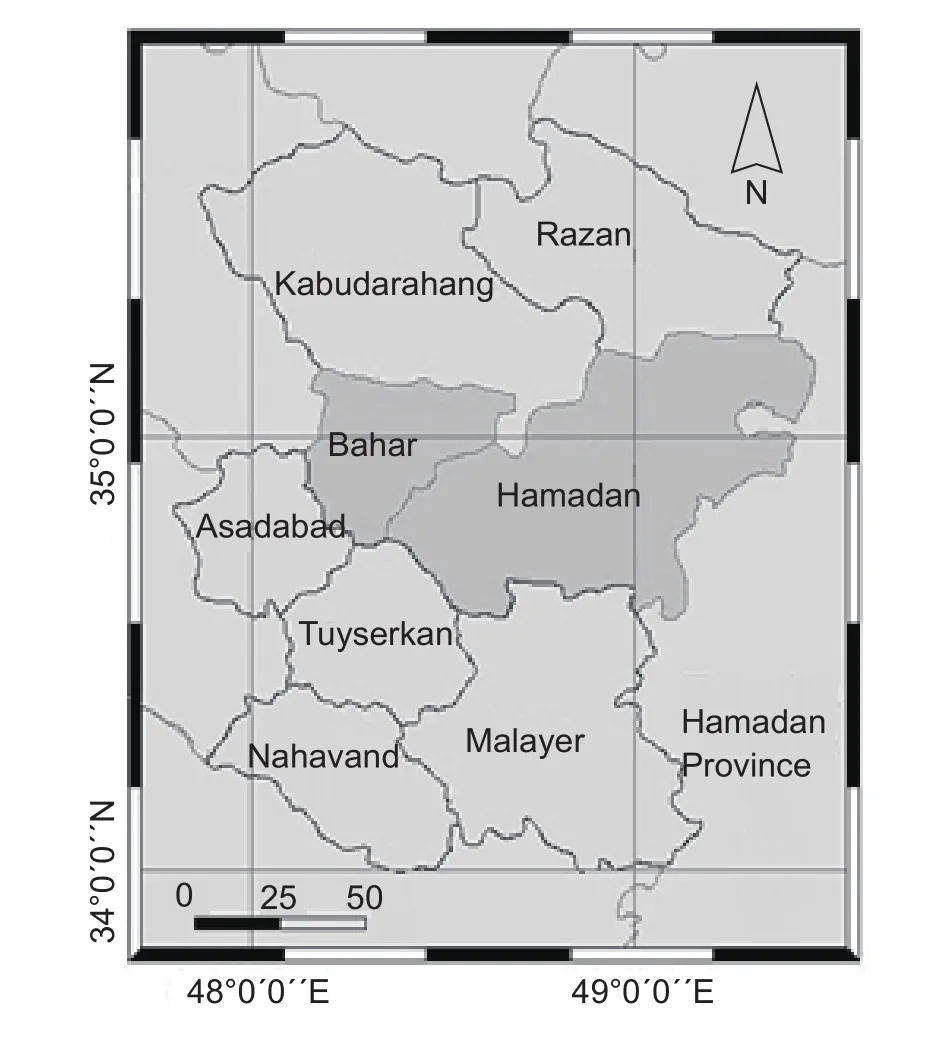
Fig. 2 The study area location in Hamadan, Iran.
2.2. Assessments of the potato production systems by the DEXi model
The term “potato cropping system” refers to the management techniques, including pest management, soil fertility strategies, water source management, and irrigation practices, which are used on a particular field over a period of years. The mentioned potato cropping systems were defined for a context corresponding to Bahar County in Hamadan Province. The regional climate is semiarid with a mean annual precipitation of 324.5 mm and mean annual temperature of 11.3°C. The mean elevation of the region is 2 038 m above mean sea-level (Akhavan et al.2010). Groundwater is the major source of water supply for agricultural sectors, as well as for drinking and domestic and industrial uses in the region. The groundwater level has continuously decreased in recent decades (Balali et al.2011). The four mentioned potato cropping systems in Hamadan Province were assessed in terms of sustainability during 2014-2015 as follows:
Traditional potato system (TPS)Historically, potato cropping systems in the north-western city of Hamadan Province typically included continuous potatoes and shortterm rotations (2 or 3 years for garlic (Allium sativum),cucumbers (Cucumis sativus), and vegetables, such as carrot (Daucus carota) and green beans (Phaseolus vulgaris)). Based on TPS, many farms are of a small size(0.5-1 ha). Rotations along with extensive tillage and minimal crop residue return during the potato phase of the rotations are the characteristics of this production system.Weeds are managed by hand and livestock manure is a key fertilizer in TPS. Only in this system, the irrigation water is originated from surface water sources and irrigation practices are done using flood irrigation systems. Water consumption in this type of irrigation is 1 100-1 800 mm ha-1.In contrast, the average yield of potato production farms is 25-35 ton ha-1for the mentioned system.
Quasi-industrial potato system (QlPS)In the Quasiindustrial potato system, crop short-term rotations include simplified cash crops, such as wheat (Triticum aestivum)and barley (Hordeum vulgare L.). Crop protection strategy of diseases and pests is mainly based on pesticides and mechanical control of weeds. Dairy manure and chemical fertilizers (NPK) are uniformly applied to the fields before planting. Water is harvested from deep and semi-deep wells and distributed through a system of pipes by pumping.Sprinkler irrigation systems are employed in QIPS.
lndustrial potato system (lPS)In the IPS, crop rotation is often removed and an intensive crop management is applied: high use of pesticides and fertilizers, high sowing rates and usual sowing dates, lack of mechanical weeding,and use of active substances for weed control. Therefore,herbicide rates are higher than average (typically, four times and about 6 kg ha-1or 6 L ha-1). Drip irrigation systems are installed after planting potato seeds. Thin-walled drip tapes are placed on the soil surface at the center of the raised beds.
Government-promoted potato system (GPPS)A government project called GPPS in this article aimed at reducing the environmental impact of potato production in the region in the early stages. The irrigation system was similar to that of IPS with the exception of more emphasis on water management. A pest management strategy was developed under the rubric of ‘integrated control’ to employ a range of different control measures constrained by their compatibilities and required for minimizing noxious effects in the wider environment. The main method of saving water in the 4th system was evaluated by using drip irrigation and the limited use of fertilizers and pesticides (Table 1). GPSS with the production of 30-40 ton of tuber and consumption of 720-830 mm ha-1of irrigation water was found to have a better performance than the other systems.
3. Approach and methodology
3.1. The DEXi decision support system
Different potato cropping systems and their properties were additionally compared in this study. MCDM was suitable for the evaluation of the best rated alternative (Bohanec et al. 2008). DEX is based on a very simple principle of decomposing a decision problem into smaller,less complex sub-problems via a hierarchy of attributes (Bohanec et al. 2013).The model is gradually manipulated by the following four steps: (1) attribute identification; (2) attribute structuring; (3) attribute scale definition; and (4)aggregation definition (Bohanec et al. 2008; Ravnikar et al. 2016).
As a decision-support system, DEXi Software is based on DEX methodology(Bergez 2013; Bohanec et al. 2013; Craheix et al. 2015), which applies qualitative instead of quantitative variables and decision rules rather than numerical functions to aggregate attributes (Bohanec et al. 2017). However, this approach allows combining quantitative and qualitative indicators unlike the MAUT, which is only based on the quantitative data. Hereof, the qualitative assessments of indicators can be compared with the quantitative assessments. The system performance will be low if energy use efficiency (EUE) is less than 0.5 kg MJ-1and it will be high if EUE is higher than 0.66 kg MJ-1(Bockstaller et al.2008; Sadok et al. 2008; Pelzer et al. 2012).
The hierarchy of the derived indicators is also considered in the DEXi model.The possible qualitative indicators in this model are characterized by their names, descriptions, and scales. These discrete values are described in words like “low”, “low-to-medium”, “medium”, “medium-to-high”, and “high” rather than in numbers. Also, a range of quantitative values can be accompanied with some qualitative states. The model’s inputs would make the basic indicators (Pelzer et al. 2012). As described by Craheix et al. (2015), the above-mentioned tools and methodology were utilized to design the preliminary models for assessing the cropping systems in this research.
Formally, S of DEXi model is a 4-tuple S=(U, Q, V, F), where, U is the collection of attributes; Q is the collection of value domains (scales) of attributes;V is the descendant function that determines the hierarchical structure of S;and F is the collection of aggregation functions (Greco et al. 2002; Trdin and Bohanec 2017).
As an easy and natural application for qualitative variables, DEXi uses the flexible decision rules, by which the combinatorial aspects of aggregation can be dealt with. Also, it helps to model attribute dependency based on tabular expert-defined aggregation rules (section 3.2). For instance, the effects of energy, water, and land use efficiencies defined for resource use efficiency in Table 2 provide all the decision rules in the supplementary material as a DEXi file. In fact, a simple ‘if-then’ rule determining land use efficiency value for each row is based on a combination of values of energy, water, and land use efficiencies in this table. In a contingency table, each of the three sub-criteria of four classes was aggregated for a criterion to yield 125 decision rules (53=125).
3.2. Selection and hierarchy of indicators
In the first step, we selected a wide spectrum of criteria utilized based on their emphasis in the sustainability assessment literature. Then, we classified them into three dimensions, including: (i) ability to discriminate between the evaluated cropping systems (Bechini and Castoldi 2009; Deytieux et al. 2016);(ii) ability to supply information on the other criteria, which are difficult to access to (Bockstaller et al. 2008); (iii) flexibility and data availability (de Olde et al. 2016); and (v) validity and sensitivity (Blattert et al. 2017). Then, the criteria and descriptions were exactly sent to the participants in the study. The participants were selected based on the expertise of 15 people in the various fields of agriculture, i.e., ecology, economy, plant protection,social science, and agricultural extension, one third of whom were researchers in the universities, one third were professional agricultural consultants, and one third were public sector experts. Also, 87 farmers, who were selected based on varied specifications representing their interests,like cultivated area, cropping system, region, etc., were asked to rate the criteria. The sum of the average scores of the two groups was the standard practice of selecting the criteria to design the primary model. Finally, the model was presented to the participants and the final comments were made in the presence of the experts.


Table 2 Some rules for predicting the resource use efficiency based on energy, water, and land use efficiencies
The assessment criteria were structured into a hierarchy after being selected. Sustainability was disaggregated into several sub-criteria through a top-down hierarchy. The overall evaluation was divided into the three environmental,economic, and social dimensions (Pelzer et al. 2012; Veisi et al. 2015). Social sustainability was divided into four indicators: employment (fixed employment), supply chain(access to knowledge and inputs), protection (governmental support and social acceptability), and operational difficulties.Economic sustainability was divided into profitability (benefitcost ratio and net profit) and productivity (labor, land, and capital productivities). Environmental sustainability was divided into three indicators: resource use (energy, water,and land uses), independence of pesticides (amounts and risks of pesticides, herbicides, and insecticides), and biodiversity (ecological buffer zones and species richness).The indicators are represented in Fig. 3.
3.3. Measurement criteria
Using DEXi Software, the basic criteria could be disaggregated in detail (formal expertise) or calculated via direct qualitative expertise. The data of economic and social dimensions were collected by sampling through a cost-benefit analysis and face-to-face interviews using a questionnaire of open and closed questions, respectively (Lopez-Ridaura et al. 2002; Zhen and Routray 2003). Using the average over the preceding three years of 2013-2015, similar purchase and selling prices were considered for the inputs and crops of the four cropping systems assessed based on the economic dimension, respectively (Craheix et al.2016). On the other hand, the environmental dimensions of pesticide independence, biodiversity, and resource use were evaluated through a technical monitoring of dossier per plot, flora survey, and field survey and sampling together with energy input-output analysis, respectively (Rockstrom et al. 2004; Li et al. 2007; Alipour et al. 2012). Water use efficiency (WUE) of the potato plants was calculated as Tuber yield (kg ha-1)/Water applied through irrigation (m3ha-1) and consumed as evapotranspiration during the entire growing season (Veisi et al. 2015; Alenazi et al. 2016). In Table 3, the environmental threshold values utilized in the sustainability assessments of the potato cropping systems are presented for some criteria of the DEXi model. Except for the biodiversity indicators that were studied on an agroecosystem scale, other data were collected at the farm,field, or cropping system scales (Bockstaller et al. 2008,2011). Accordingly, 5, 21, 25, and 32 farms of GPPSs, IPSs,TPSs, and QIPSs were examined in Hamadan Province in this investigation.
3.4. DEXi weaknesses and challenges
In this research, the benefits of traditional methods were considered besides the weaknesses of the proposed method. Accordingly, in the social dimension of the DEXi model, estimations of some basic indicators were difficult due to the model’s subjectivity, complexity, and low sensitivity in some cases (Pelzer et al. 2012). In addition,we faced some challenges like selecting the indicators and thresholds and weighting the criteria when using this method(Craheix et al. 2015). For example, the main difference between the two groups of participants was related to the weight of each of the three dimensions of sustainability.For example, the group of experts gave a higher weight to the ecological dimension and the farmers believed that the economic dimension was higher. In addition, the experts essentially selected the varied indicators based on their beliefs with few similarities between their choices. For such reasons, similar studies have been discussed by the experts in different parts of the world to bring their views closer together and design a suitable model for the regions. Also,what is most important for authors is estimating whether it can really correspond to reality or not, especially based on the ecological dimension. Furthermore, quantitative evaluation methods can be helpful besides the threshold values determined for each indicator.
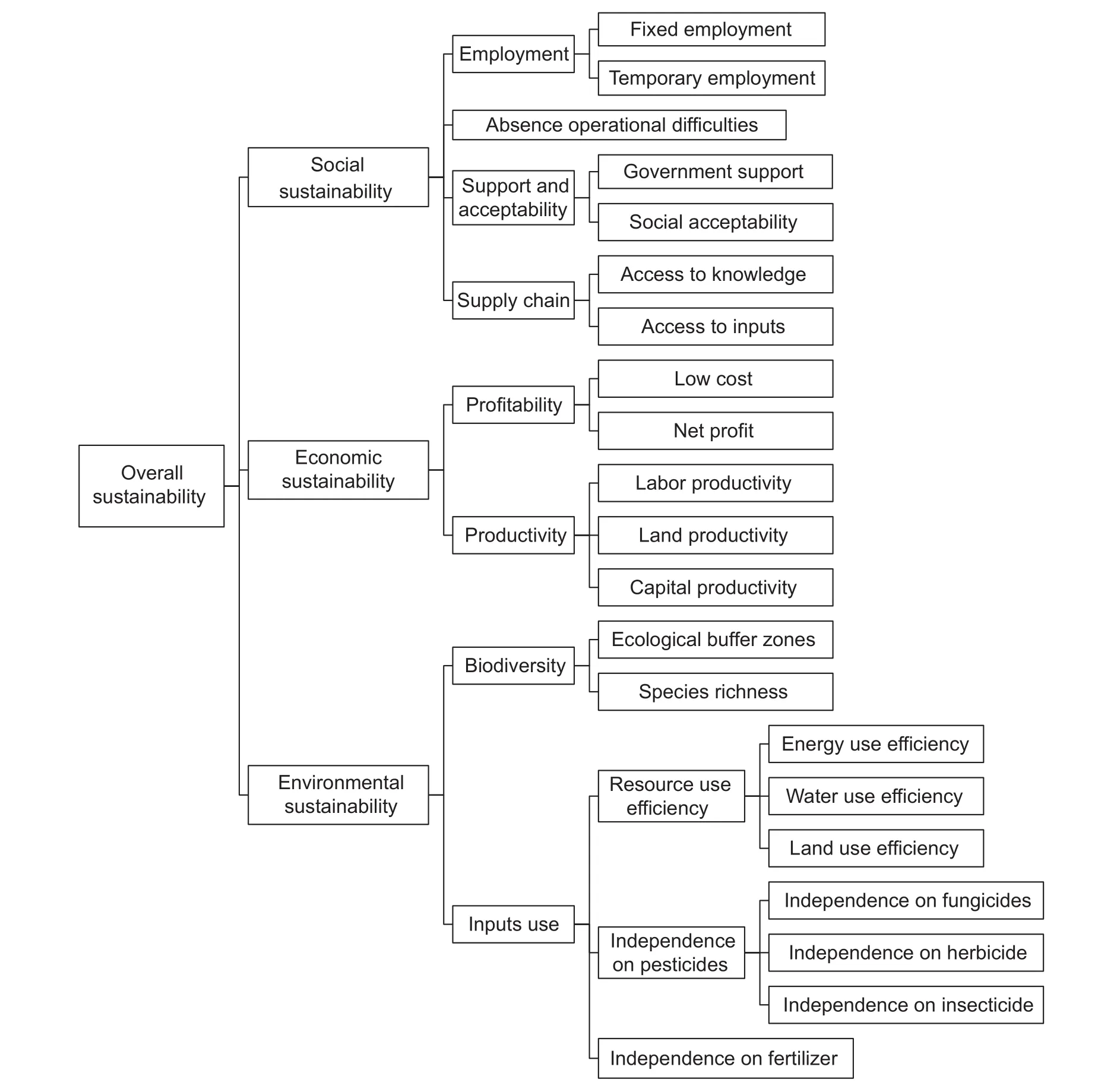
Fig. 3 The DEXi decision hierarchy applied to assess the overall sustainability of the potato cropping systems (hierarchical structure).

Table 3 The threshold values of some criteria used for the sustainability assessment of potato cropping systems based on the environmental branch of the DEXi model1)
4. Results and discussion
4.1. Sensitivity analysis
To gain a more confident model and improve transparency,sensitivity analysis can be applied as an alternative (Bergez 2013). In this research, this analysis was performed using IZI-EVAL interface (http://wiki.inra.fr/wiki/deximasc/Interface+IZI-EVAL/Accueil). Thus, assessment of the innovative cropping systems based on a multi-criteria sustainability could be facilitated. Obtaining a high score through the relatively even frequency distributions of Monte-Carlo SA was difficult but plausible. Therefore,the frequencies of 0.5, 0.25, 0.52, 0.15, and 0.004 were achieved for scores 1-5 of the overall sustainability as the root attributes, respectively (Fig. 4).
Using conditional probabilities, 9 out of 21 basic criteria were found to have an sensitivity index (SI) of larger than 0.02: low cost (0.06), net profit (0.06), independence of fertilizer (0.06), lack of operational difficulties (0.05), land productivity (0.04), capital productivity (0.04), ecological buffer zones (0.04), species richness (0.04), and labor productivity (0.03) (Fig. 5).
4.2. Overall sustainability
In the sustainability assessments of the potato cropping systems, few differences were highlighted by the DEXi model based on the indicators at the top part of the hierarchy. The overall sustainabilities of the potato cropping systems were low, low-to-medium, or medium,while being at least equal to or better than those of the current potato cropping systems based on GPPS (Fig. 6).In this context, TPS, IPS, QIPS, and GPPS got the lowest(low), slightly better (low-to-medium), highest (medium),and highest (medium) overall assessments, respectively.A more detailed look at the evaluations achieved at the model’s lower levels revealed the reasons for such results. From the economic viewpoint, all the potato cropping systems were indistinguishable with a medium value, except for TPS with a low value due to a lower net profit and productivity (land and labor productivities).In TPS, the dimension of economic sustainability had a stronger negative effect on the overall sustainability score obtained by DEXi compared to the other dimensions,while a “medium-to-high” score was obtained for the social dimension in this system. It should be noted that the low overall sustainability of TPS urged us to consider veto thresholds for all the other three dimensions with a low score. Thus, a low score was achieved for the economic dimension via TPS. The thresholds could affect the degrees of compensation among the different criteria(Buchholz et al. 2009; Cinelli et al. 2014). The main differences between IPS and the other potato cropping systems were caused by the ecological indicators.Although GPPS got a medium score in all the three dimensions, there is a long way towards achieving a high score for sustainability in this system.

Fig. 4 Frequency by scores of 5 000 Monte-Carlo simulations of DEXi for the basic criteria.
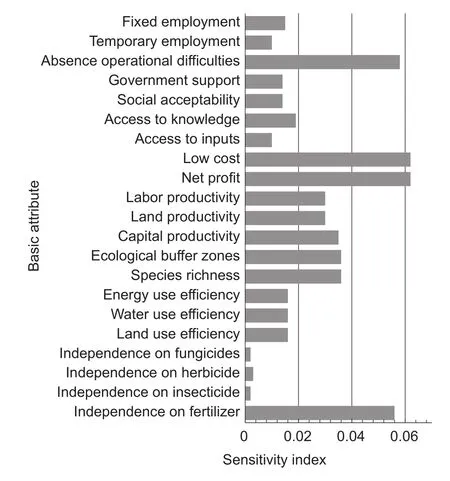
Fig. 5 Sensitivity index of each basic criterion calculated based on the root variable.
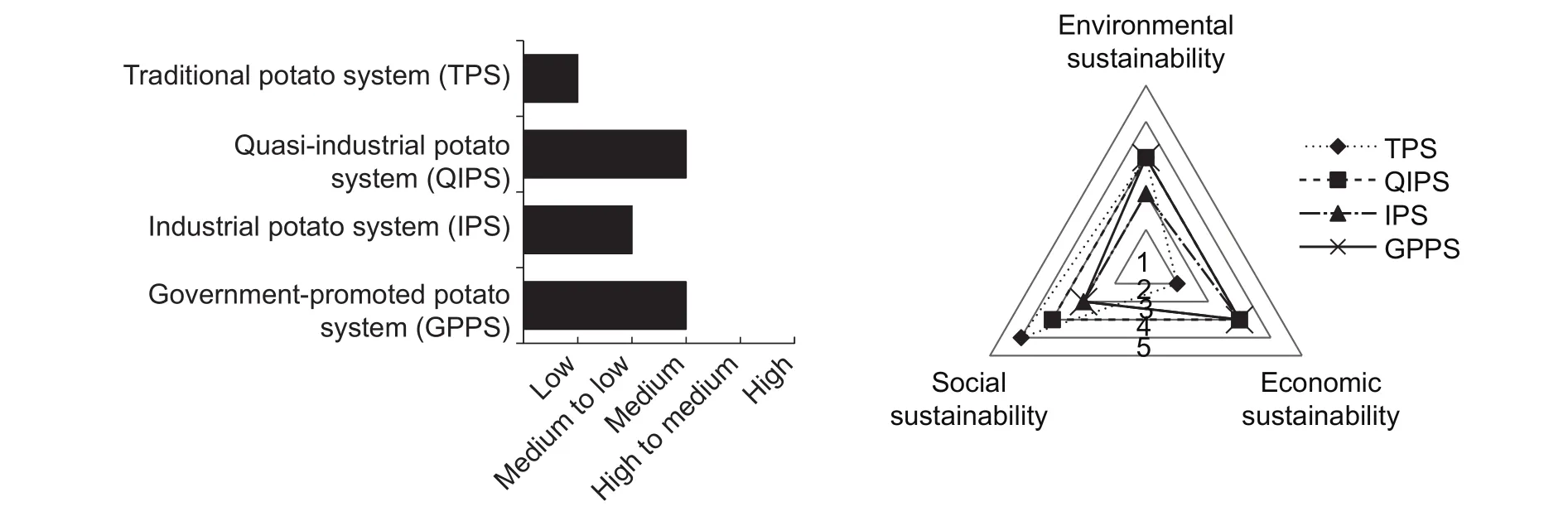
Fig. 6 The overall sustainability assessment for the four potato cropping systems in Hamadan Province, Iran. Numbers 1, 2, 3,4 and 5 in the radar graph denote the low, medium to low, medium, high to medium and high level of sustainability, respectively.
4.3. Environmental sustainability
While the environmental sustainability of GPPS was improved compared to that of IPS, there were no positive changes compared to the other two systems in spite of the resource use improvement. Rather, GPPS had failed to get a score of higher than “low-to-medium” based on the aggregated criteria of biodiversity and fertilizer independence (Fig. 7). For IPS, the results showed an ecological deficit in the aggregate attributes of biodiversity,independence of pesticides, and independence of fertilizers and the basic attribute of EUE, thus gaining a very small level of environmental sustainability (low-to-medium). Its inner fragility was derived from its own reliance on high intensity and non-renewable resource use so that its own energy performance indicators were not substantially different. For the environmental dimension, TPS obtained the best scores in the ecological buffer zones as indicated in more details in Fig. 7. Compared to the other potato cropping systems, the mentioned systems demonstrated better results for the aggregation attributes of “biodiversity”and “independence of pesticides” and the basic attribute of “independence of fertilizer”. However, their own environmental sustainabilities were similar to those of QIPS and GPPS with moderate performances. The indicators of independence of pesticides, herbicides, and insecticides,as well as fertilizers revealed that TPS (medium-to-high)had a better behavior than the other systems, while IPS(low) had the worst performance than others. WUE was the biggest advantage of GPPS (high), while it was the biggest disadvantage of TPS.
4.4. Economic sustainability
In the economic dimension, GPPS did not indicate a higher score compared to the other systems, except for TPS. The worst assessment (low) was given to the basic criteria of labor productivity, land productivity, and net profit in TPS,while it was successful based on the basic criterion of low cost (medium-to-high). Therefore, the main difference was its lower production cost (lower costs of irrigation,fertilizer, and pesticide). The economic sustainability scores of the various cropping systems were “low” in TPS and “medium” in the other cropping systems. Land productivity in IPS (high) and TPS (low) had the highest and lowest scores, respectively, while GPPS (mediumto-high) and QIPS (medium) were ranked on the second and third overall sustainabilities (Fig. 8). Net profit was the best in QIPS due to providing a lower production cost and increased profitability that led to a higher gross margin.The economic sustainability of TPS remained low despite its lower production costs compared to those of all the other systems. The low-cost and productivity scores were higher for IPS (low-to-medium and high, respectively) compared to GPPS (low and medium-to-high, respectively). The main difference was the lower production cost for IPS (lower soil fertility, pest control, and irrigation system’s costs) compared to those of GPPS.
4.5. Social sustainability
Depending on the cropping system, social sustainability was estimated to be “medium-to-high”, “medium”, and“low-to-medium” for TPS, QIPS, and IPS and GPPS,respectively (Fig. 9). GPPS obtained a high score based on the aggregated criteria of support and acceptability. On the contrary, social sustainability for farmers was higher in TPS than in the other three systems due to higher employment,indigenous knowledge, and very low operational difficulties.The operational difficulties were higher for IPS and GPPS,while the supply chain demonstrated greater operational difficulties in GPPS compared to the other cropping systems.The employment score was higher in all the traditional systems because of the lack of machinery and human labor force used in the weed control and irrigation operations.Furthermore, the basic criterion of inputs was the best in TPS assessment due to the presence of primary inputs like manure in the system, as well as cheap labor force in the area. However, no best results were obtained in QIPS based on any of the basic and aggregated criteria though a medium score was gained for it in terms of social sustainability, which was higher than those of IPS and GPPS.

Fig. 7 Environmental sustainability assessment for the four potato cropping systems in Hamadan Province, Iran. Numbers 1, 2,3, 4 and 5 in the radar graph denote the low, medium to low, medium, high to medium and high level of sustainability, respectively.
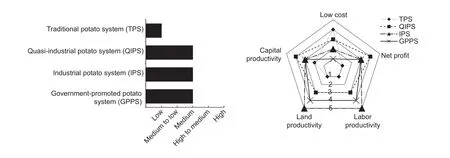
Fig. 8 Economic sustainability assessment for the four potato cropping systems in Hamadan Province, Iran. Numbers 1, 2, 3,4 and 5 in the radar graph denote the low, medium to low, medium, high to medium and high level of sustainability, respectively.
5. Conclusion
As a quite effective hierarchical method, DEXi can be used for modeling a wholly qualitative multi-attribute decision in innovative systems. Besides supporting decision making in the fields of sustainability evaluation and protection of the environment and agricultural region, DEXi model as a suitable, simple, and friendly computerized tool can compare the systems in a given context and answer important questions like these: What consequences will sustainable to if the current conditions change in one or more attributes?And what are the main attributes, which can be changed to make innovative cropping systems? According to the results of this study, it can be concluded that GPPS with distinctive economic and social profiles can provide a better overall sustainability despite the fact that some indicators may be negatively affected by it. Accordingly, in response to the question of whether DEXi could answer “what-if”questions (e.g., what changes to the context components can lead to more attractive potato cropping systems that are acceptable for the farmer, society, environment, etc.),the following suggestions can be proposed for GPPS to be more sustainable: (1) biodiversity enhancement; (2) input substitution strategy; and (3) best management practices for potato through irrigation. Of course, this is not the end and the government needs to develop plans to create employment outside the agricultural sector and provide education programs inside it.

Fig. 9 Social sustainability assessment for the four potato cropping systems in Hamadan Province, Iran. Numbers 1, 2, 3, 4 and 5 in the radar graph denote the low, medium to low, medium, high to medium and high level of sustainability, respectively.
Acknowledgements
We express our sincere thanks to the University of Mohaghegh, Ardabili, Iran for funding this research. We also thank Mr. Morteza Hazhir-Kamal from Shahed University,Iran and Mr. Akbari Moein from Azad University of Sanandaj,Iran for their help in conducting the field survey.
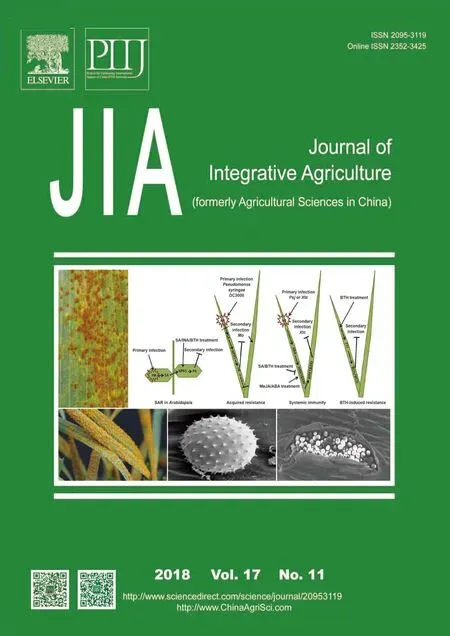 Journal of Integrative Agriculture2018年11期
Journal of Integrative Agriculture2018年11期
- Journal of Integrative Agriculture的其它文章
- First report of Athelia bombacina causing postharvest fruit rot on pear
- Effect of long-term continuous cropping of strawberry on soil bacterial community structure and diversity
- Alternate row mulching optimizes soil temperature and water conditions and improves wheat yield in dryland farming
- lnter-annual changes in the aggregate-size distribution and associated carbon of soil and their effects on the straw-derived carbon incorporation under long-term no-tillage
- Mycoplasma leachii causes polyarthritis in calves via the blood route but is not associated with pneumonia
- Genome-wide detection of selective signatures in a Duroc pig population
